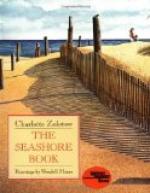His front part—we might call it a nose—will stretch out to a fine point; and it contains a rasping tongue even harder than that of the Periwinkle. He sets to work. Moving the rasp up and down, he drills a neat round hole in the shell of the animal he is attacking. No shell is safe from him; and no tool could make a neater hole.
When you next gather shells on the beach, look at them closely; in some you will see where Mr. Whelk, the burglar, has been at work. He needs but a small entrance to enable him to suck out his helpless prey at his ease. Is it not strange that this creature, with a body as soft as your tongue, should earn its living by breaking into houses made of hard shell!
There are other molluscs which find their meals in this strange manner, and many others which, like the Periwinkle, feed more easily on seaweed. One of these, the Limpet, you can always be sure of finding at low tide; indeed, there are so many Limpets on the rocks that it would be hard not to see them. You will know, if you have tried to force a Limpet from its hold on the rock, how very tightly it clings. It is as if the shell were glued or cemented by its edges.
Yet there is no glue or cement used, but only a simple dodge. The Limpet has a broad “foot,” which almost fills up the opening of its shell. Like the foot of the Snail, it is used when the animal wishes to take a walk; but it serves another purpose too. It can be used as a sucker; and it is this which enables the Limpet to cling so firmly to its rock.
When the tide is out, the Limpet clings to the rock, its soft body tucked safely away in the shell. Its feeding time comes when the water covers the rocks once more. Then the Limpet’s shell may be seen to tilt up, and a foot, and a head with feelers and eyes, come out. The Limpet crawls to the seaweed and begins to browse, using a rasp like that of the Periwinkle. It then crawls back to its own place on the rock. In time this resting-place becomes hollowed out, and the Limpet’s shell fits into the groove thus made.
Limpets are useful as bait for fish. The Whelk and Periwinkle are gathered in immense numbers, and are used by us for food. Perhaps you have seen the egg-bundle of the Whelk. It contains many eggs when first laid in the sea. Each egg is as big as a pin’s head. They swell in the water, until the yellowish bundle is three times as large as the Whelk that laid it. You often see the empty bundle blown by the wind along the shore.
EXERCISES
1. Give the names of two bi-valve molluscs.
2. What is the Periwinkle’s shell made of?
3. Describe how the Periwinkle eats seaweed.
4. How does the Whelk obtain its food?
5. Give the names of three one-shelled molluscs.
LESSON XI.
SHELLS AND THEIR BUILDERS (2)




